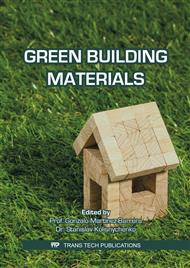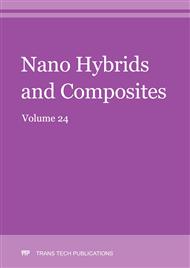[1]
Benhelal E et al (2013) Global strategies and potentials to curb CO2 emissions in cement industry. J Clean Prod 51:142–161.
DOI: 10.1016/j.jclepro.2012.10.049
Google Scholar
[2]
Scrivener, K.L., Nonat, A., 2011. Hydration of cementitious materials, present and future. Cem. Concr. Res. 41 (7), 651–665.
DOI: 10.1016/j.cemconres.2011.03.026
Google Scholar
[3]
Kırgız, M.S., Pulverized Fuel Ash Cement Activated by Nanographite,, ACI Materials, Vol. 115, No. 6, p.803–812, (2018).
DOI: 10.14359/51689101
Google Scholar
[4]
Kırgız, M.S., Green cement composite concept reinforced by graphite nano-engineered particle suspension for infrastructure renewal material, Composites Part B, Vol. 154, No. 12, p.423–429, 2018.
DOI: 10.1016/j.compositesb.2018.09.012
Google Scholar
[5]
Kırgız, M.S., Effect of mineralogical substitution raw material mixing ratio on mechanical properties of concrete, ZKG International, No. 10, p.30–41, (2018).
Google Scholar
[6]
Kırgız, M.S., Advancements in Properties of Cement Containing Pulverised Fly Ash and Nanomaterials by Blending and Ultrasonication Method (Review- Part I),, Nano Hybrids and Composites, vol. 19, pp.1-11, 2018.
DOI: 10.4028/www.scientific.net/nhc.19.1
Google Scholar
[7]
Kırgız, M.S., Fresh and Hardened Properties of Green Binder Concrete Containing Marble Powder and Brick Powder, European Journal of Environmental and Civil Engineering, Issue sup1: Supplement: Green Binder Materials for Civil Engineering and Architecture Applications, Vol. 20, pp.64-101, 2016.
DOI: 10.1080/19648189.2016.1246692
Google Scholar
[8]
Flower, David J.M., Sanjayan, Jay G., 2007. Greenhouse gas emissions due to concrete manufacture. Int. J. LCA 12 (5), 282–288.
Google Scholar
[9]
Al-Jabri KS. The use of industrial waste materials and by-products in cement production. In: Lackner M, editor. High temperature processes in chemical engineering, May. Vienna: ProcessEng Engineering GmbH; 2010 [chapter 9].
Google Scholar
[10]
Hannesson G et al (2012) The influence of high volume of fly ash and slag on the compressive strength of self-consolidating concrete. Constr Build Mater 30:161–168.
DOI: 10.1016/j.conbuildmat.2011.11.046
Google Scholar
[11]
Kırgız, M.S., Strength Gain Mechanism for Green Mortar Substituted Marble Powder and Brick Powder for Portland Cement, European Journal of Environmental and Civil Engineering, Issue sup1: Supplement: Green Binder Materials for Civil Engineering and Architecture Applications, Vol. 20, pp.38-63, 2016.
DOI: 10.1080/19648189.2016.1246691
Google Scholar
[12]
Kırgız, M.S., Advancements in Mechanical and Physical Properties for Marble Powder–Cement Composites Strengthened by Nanostructured Graphite Particles, Mechanics of Materials, Vol. 92, No.1, p.223–234, 2016.
DOI: 10.1016/j.mechmat.2015.09.013
Google Scholar
[13]
Kırgız, M.S., Advance Treatment by Nanographite for Portland Pulverised Fly Ash Cement (The class F) Systems,, Composites Part B, Vol. 82, No. 12, p.59–71, 2015.
DOI: 10.1016/j.compositesb.2015.08.003
Google Scholar
[14]
Heidrich C, Feuerborn H-J, Weir A (2013) Coal combustion products: a global perspective. In: WOCA.
Google Scholar
[15]
Kırgız, M.S., Use of ultrafine marble and brick particles as raw materials in cement manufacturing,, Materials and Structures, Vol. 48, No. 9, p.2929–2941, (2015).
DOI: 10.1617/s11527-014-0368-6
Google Scholar
[16]
Kırgız, M.S., Advances in physical properties of C class fly ash–cement systems blended nanographite (Part 2),, ZKG International, No.1-2, p.60–67, (2015).
Google Scholar
[17]
Kırgız, M.S., Advances in physical properties of C class fly ash–cement systems blended nanographite (Part 1),, ZKG International, No.12, p.42–48, (2014).
Google Scholar
[18]
Kırgız, M.S., Strength Gain Mechanisms of Blended-Cements Containing Marble Powder and Brick Powder,, KSCE Journal of Civil Engineering, Vol. 19, No.1, p.165–172, (2015).
DOI: 10.1007/s12205-014-0557-4
Google Scholar
[19]
Joshi RC, Lohita R (1997) Fly ash in concrete: production, properties and uses. CRC Press, Boca Ro.
Google Scholar
[20]
Siddique, Rafat, Prince, William, Kamali, Siham, 2007. Influence of utilization of high-volume of Class F fly ash on the abrasion resistance of concrete. Leonardo Electron. J. Pract. Technol. 10, 13–28.
Google Scholar
[21]
Lammertijn, S., De Belie, N., 2008. Porosity, gas permeability, carbonation and their interaction in high-volume fly ash concrete. Mag. Concr. Res. 60 (7), 535–545.
DOI: 10.1680/macr.2008.60.7.535
Google Scholar
[22]
Kırgız, M.S., Use of ultrafine marble and brick particles as alternative raw materials for clinkerization,, ZKG International, No.4, p.36–44, (2014).
Google Scholar
[23]
Kırgız, M.S., Effects of Blended–Cement Paste Chemical Composition Changes on Some Strength Gains of Blended–Mortars,, Materials Science / J. of Sci. W., http://dx.doi.org/10.1155/2013/625350, Vol.2014, p.11, (2014).
DOI: 10.1155/2014/625350
Google Scholar
[24]
Kırgız, M.S., Characteristic Properties of Marble and Brick Powders,, Bio-Medical Materials and Engineering / J. of Ad. Mater. Res., Vol.749, p.483–490, (2013).
DOI: 10.4028/www.scientific.net/amr.749.483
Google Scholar
[25]
Kırgız, M.S., Chemical Properties of Substituted and Blended Cements,, Bio-Medical Materials and Engineering / J. of Ad. Mater. Res., Vol.749, p.477–482, (2013).
Google Scholar
[26]
Atis_, Cengiz Duran, 2005. Strength properties of high-volume fly ash roller compacted and workable concrete and influence of curing condition. Cem. Concr. Res. 35, 1112–1121.
DOI: 10.1016/j.cemconres.2004.07.037
Google Scholar
[27]
Latha, K.S., Rao, M.V.S., Reddy, S., 2012. Estimation of GGBS and HVFA strength efficiencies in concrete with age. Int. J. Eng. Adv. Technol. 2 (2), 221–225.
Google Scholar
[28]
John, Jino, Ashok, M., 2014, Strength study on high volume fly ash concrete, Int. J. Adv. Struct. Geotech. Eng. 3 (2), 1680171.
Google Scholar
[29]
Shaikh F, Supit S, Sarker P (2014) A study on the effect of nano silica on compressive strength of high volume fly ash mortars and concretes. Mater Des 60:433–442.
DOI: 10.1016/j.matdes.2014.04.025
Google Scholar
[30]
Li, Gengying, 2004. Properties of high-volume fly ah concrete incorporating nano-SiO2. Cem. Concr. Res. 34, 1043–1049.
DOI: 10.1016/j.cemconres.2003.11.013
Google Scholar
[31]
Morsy MS, Alsayed SH, Aqel M, Effect of nano-clay on mechanical properties and microstructure of ordinary Portland cement mortar Int. J. Civil Environ. Eng., 10 (1) (2010), p.23–27.
Google Scholar
[32]
Shoukry H, Kotkata MF, Abo-EL-Enein SA, Morsy MS (2013) Flexural strength and physical properties of fiber reinforced nano metakaolin cementitious surface compound, J Construct Build Mater 43: 453-460.
DOI: 10.1016/j.conbuildmat.2013.02.030
Google Scholar
[33]
AL-Salami AE, Morsy MS, Taha S, Shoukry H (2013) Physico-mechanical characteristics of blended white cement pastes containing thermally activated ultrafine nano clays. Construct Build Mater 47: 138–145.
DOI: 10.1016/j.conbuildmat.2013.05.011
Google Scholar
[34]
M.S. Morsy, Y. Al-Salloum, T. Almusallam, H. Abbas, Effect of nano-metakaolin addition on the hydration characteristics of fly ash blended cement mortar, J. Therm. Anal. Calorim. 116 (2013) 845–852.
DOI: 10.1007/s10973-013-3512-6
Google Scholar
[35]
Mahir dham (2007) nanomodificaion of cement matrix for enhanced ductility and fracture properties in concrete, PhD thesis, University of Florida.
Google Scholar
[36]
Al-Jabri K, Shoukry H (2014) Use of nano-structured waste materials for improving mechanical, physical and structural properties of cement mortar. J. Constr. Build. Mater., 73: 636–644.
DOI: 10.1016/j.conbuildmat.2014.10.004
Google Scholar
[37]
Shoukry H, Kotkata MF, Abo-EL-Enein SA, Morsy MS, Flexural strength and physical properties of fiber reinforced nano metakaolin cementitious surface compound, J. Constr. Build. Mater. 43 (2013) 453–460.
DOI: 10.1016/j.conbuildmat.2013.02.030
Google Scholar
[38]
M.S. Morsy, S.H. Alsayed, M. Aqel, Effect of nano-clay on mechanical properties and microstructure of ordinary Portland cement mortar, Int. J. Civil Environ. Eng. 10 (2010) 23–27.
Google Scholar
[39]
Kırgız, M.S., Supernatant Nanographite Solution for Advance Treatment of C Class Fly Ash–Cement Systems (Part 2),, ZKG International, No. 5, p.42–47, (2015).
Google Scholar
[40]
Kırgız, M.S., Supernatant Nanographite Solution for Advance Treatment of C Class Fly Ash–Cement Systems (Part 1),, ZKG International, No. 4, p.56–65, (2015).
Google Scholar
[41]
Kırgız, M. S., Chemical properties of blended cement pastes,, Journal of Construction Engineering and Management, Vol. 137, No. 12, p.1036–1042, (2011).
Google Scholar



